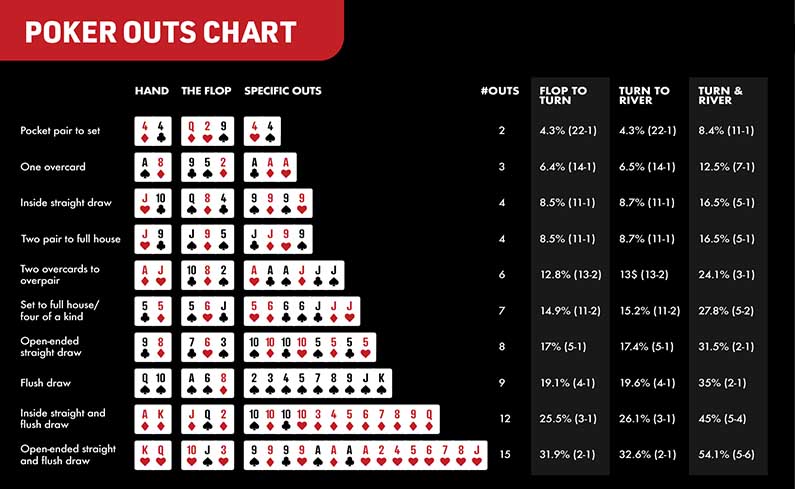
Posted in Guides November 16, 2019
All About Poker Odds
If you have some basic knowledge of how to play poker, understand that statistics can play to your advantage… but don’t quite know how. No worries, it does not require some hard math skills. Most players memorise these basic hands with practice, so keep poker odds guides handy while you practice and it will get easier over time. Some of the best poker players of all time began their career by applying these principles that they later tweaked in more personal and complex strategies.
What are poker odds?
Odds are the chances of winning a hand based on your dealt cards, the cards on the table and your call position. To know this you must first learn to calculate poker outs.
What are poker outs?
Outs are the cards the will help you improve your hand compared to what you think the other contenders have.
- In this example you have Q-9.
- The dealer lays A-K-7-4.
- We don’t know what the opponent has.
- To win we need cards of hearts like J-9, 10-5, 7-3, 6-4-2.

So far we can determine the following information with what we can see on the table: There are 13 cards in each suit and 4 heart cards are on the table (the two the dealer placed and ours). So there are only 9 hearts left over, the ones we need to win. These are our 9 “outs”.
Using the poker outs
In a deck there are a total of 52 cards. Two of those hearts we posses and see two more on the table. 46 are left. We have 9 outs to win the hand, this leaves 37 cards left that can make us lose. Your odds of getting the card you need are 37 to 9, or 4:1 chances of winning. You are 4 times more likely to lose this pot that to win, or 20% chances of winning.
Are odds of 20% enough to take this bet or should we pass?
Our contenders could be in a similar or worst position, or they could already have a great combination of cards or about to get one. To decide if we continue depends on a risk/reward quick analysis.
How much money could you win compared to the size of your opponent’s bet?
20% odds is not something too confident to call a huge bet from your opponent. Walk away if that happens.
But if instead your rival makes a small bet, we can match that to see the river card.
For this example let’s say there is $90 on the table, the opponent just made a $10 call. We match that call and the total pot is now $100.
This action just increased our paying odds to 10:1 ($10 dollars to make for every $1 bet). This is the same as if you were betting on a team to win with odds of 4:1 and the bookmaker is paying you 10:1. Taking the call is a great decision since the reward is more than double the risk cost. You might still lose but we lose small and win big if we make it. As long as the risk is small we can take our chances.
Simple rule of thumb to calculate poker outs and odds
- After the flop (first three cards dealt on the table), calculate the number of outs left on the deck.
- 13 (cards in deck) – cards we can see = Number of outs
- Multiply the number of outs by 4 for your odds of being dealt a winning card on the turn or river.
- From our example: 9 x 4= 36%
- After the turn (fourth card dealt), multiply the number of outs by 2 to know our chances of getting that card in the river.
- From our example: 9 x 2 = 18%
This method is not 100% precise, but good enough to help you determine if a call should be made or not. A poker statistics guide will provide more information on the different odds to win based on cards dealt.
Common poker hand odds
This cheat guide can help you get directly to the odds without calculations.
Open-Ended Straight Draws: 4.8 : 1

Four to a Flush: 4.1 : 1

Inside Straight (Belly Buster): 10.5 : 1

One pair, drawing to two pair or trips: 8.2 : 1

Overcards on a ragged board on the turn: 6.7 : 1

Drawing to a set: 22 : 1

Drawing to X outs: (46-X) / X : 1
This is a generic formula you can use to calculate the odds if none of the above show-up.
Count the number of outs and subtract from 46. Divide the result from the number of odds.
Example: If I’m drawing both to a set and to a flush, e.g. I have reason to believe my opponent has two pair, and I have AA, with four to a flush, my outs are any ace (giving me a set) plus 9 flush cards (giving me a flush), totalling 11 outs.
46 – 11 = 35
35 / 11 = 3.2
odds of receiving a winning card 3.2:1
This guide should be enough to get you started for some basic tips to win at poker. Video poker strategy is very different and the odds don’t work the same way. So don’t confuse both games.




